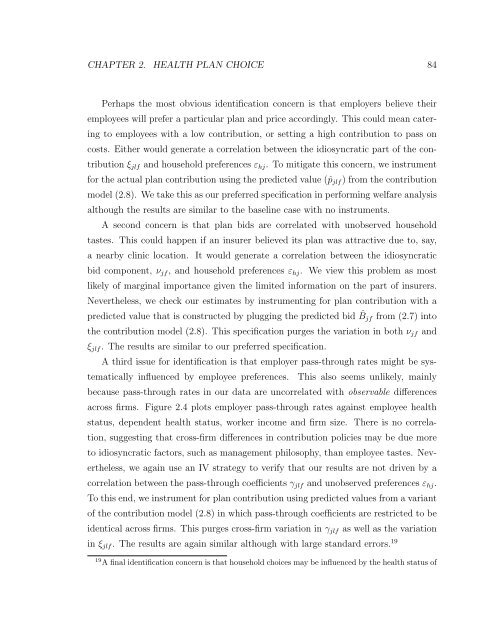essays in public finance and industrial organization a dissertation ...
essays in public finance and industrial organization a dissertation ...
essays in public finance and industrial organization a dissertation ...
You also want an ePaper? Increase the reach of your titles
YUMPU automatically turns print PDFs into web optimized ePapers that Google loves.
CHAPTER 2. HEALTH PLAN CHOICE 84<br />
Perhaps the most obvious identification concern is that employers believe their<br />
employees will prefer a particular plan <strong>and</strong> price accord<strong>in</strong>gly. This could mean cater-<br />
<strong>in</strong>g to employees with a low contribution, or sett<strong>in</strong>g a high contribution to pass on<br />
costs. Either would generate a correlation between the idiosyncratic part of the con-<br />
tribution ξjlf <strong>and</strong> household preferences εhj. To mitigate this concern, we <strong>in</strong>strument<br />
for the actual plan contribution us<strong>in</strong>g the predicted value (ˆpjlf) from the contribution<br />
model (2.8). We take this as our preferred specification <strong>in</strong> perform<strong>in</strong>g welfare analysis<br />
although the results are similar to the basel<strong>in</strong>e case with no <strong>in</strong>struments.<br />
A second concern is that plan bids are correlated with unobserved household<br />
tastes. This could happen if an <strong>in</strong>surer believed its plan was attractive due to, say,<br />
a nearby cl<strong>in</strong>ic location. It would generate a correlation between the idiosyncratic<br />
bid component, νjf, <strong>and</strong> household preferences εhj. We view this problem as most<br />
likely of marg<strong>in</strong>al importance given the limited <strong>in</strong>formation on the part of <strong>in</strong>surers.<br />
Nevertheless, we check our estimates by <strong>in</strong>strument<strong>in</strong>g for plan contribution with a<br />
predicted value that is constructed by plugg<strong>in</strong>g the predicted bid ˆ Bjf from (2.7) <strong>in</strong>to<br />
the contribution model (2.8). This specification purges the variation <strong>in</strong> both νjf <strong>and</strong><br />
ξjlf. The results are similar to our preferred specification.<br />
A third issue for identification is that employer pass-through rates might be sys-<br />
tematically <strong>in</strong>fluenced by employee preferences. This also seems unlikely, ma<strong>in</strong>ly<br />
because pass-through rates <strong>in</strong> our data are uncorrelated with observable differences<br />
across firms. Figure 2.4 plots employer pass-through rates aga<strong>in</strong>st employee health<br />
status, dependent health status, worker <strong>in</strong>come <strong>and</strong> firm size. There is no correla-<br />
tion, suggest<strong>in</strong>g that cross-firm differences <strong>in</strong> contribution policies may be due more<br />
to idiosyncratic factors, such as management philosophy, than employee tastes. Nev-<br />
ertheless, we aga<strong>in</strong> use an IV strategy to verify that our results are not driven by a<br />
correlation between the pass-through coefficients γjlf <strong>and</strong> unobserved preferences εhj.<br />
To this end, we <strong>in</strong>strument for plan contribution us<strong>in</strong>g predicted values from a variant<br />
of the contribution model (2.8) <strong>in</strong> which pass-through coefficients are restricted to be<br />
identical across firms. This purges cross-firm variation <strong>in</strong> γjlf as well as the variation<br />
<strong>in</strong> ξjlf. The results are aga<strong>in</strong> similar although with large st<strong>and</strong>ard errors. 19<br />
19 A f<strong>in</strong>al identification concern is that household choices may be <strong>in</strong>fluenced by the health status of










